From Mammal Mountains To Molehills A Human-Wildlife Conflict Perspective
In a village near me in southwest UK, there is a case of human-wildlife conflict that is causing a furore. Moles have migrated from the churchyard into adjacent gardens, raising neat mounds of unwanted earth on much-loved lawns, and horticultural ire.
Given the moniker of Mr Mole, moles are also loved by anyone in the UK who read Wind In The Willows as a child. We love that small, kindly mammal with poor eyesight, huge front paws, and super soft fur who got so bored living alone in his network of tunnels that he ventured forth to explore the outside world.
In gardens and cricket pitches, reality and fairy-tale often diverge. Moles make a mess of cultivated landscapes as they hunt for worms and larvae underground. Keen gardeners and groundsmen get cross. But wildlife sympathisers defend moles as cherished contributors to a healthy ecosystem, aerating the soil and improving drainage. People take sides. Communities divide. Discussions become heated.
(Image: Ganesh at the dedicated Shri Ganesh Mandir, Connaught Place, New Delhi)
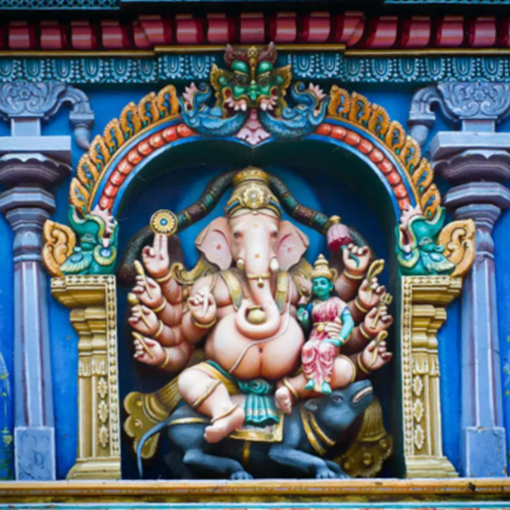
The same is true with elephants. Children adore Dumbo, the endearing elephant calf with enormous ears. And Colonel Hathi, the haughty but harmless commander of Jungle Book’s elephant patrols. Elephants are also ecologically valuable and everyone loves them – most of the time. Even people who live alongside them.
Size is the issue. Adult moles might measure five inches whereas adult elephants can be 10-13 feet tall – twice the height of most people and considerably stronger. In Asia, rural people regard them with a mix of fear and fondness. Revered as the living representative of Ganesh, the wise god who can help solve major problems, they are also feared as the neighbour who can create them.
In March 2023, I visited the project that I lead for the British Asian Trust and Elephant Family in N.E. India. Funded by the British Government’s Darwin Initiative, the project is implemented by Aaranyak, a wildlife NGO that is based in Assam. The project is tackling the growing conflict between villagers and elephants caused by creeping incursions into elephant habitat by human settlements, their associated agriculture and livestock, as well as infrastructures such as roads, railways, and industrial sites.
(Image: The Elephant God Ganesh, seen here at the Mandir Temple in Guwahati, is needed as much by his living counterparts as he is by people to solve the problem of conflict and find a way for both parties to coexist.)
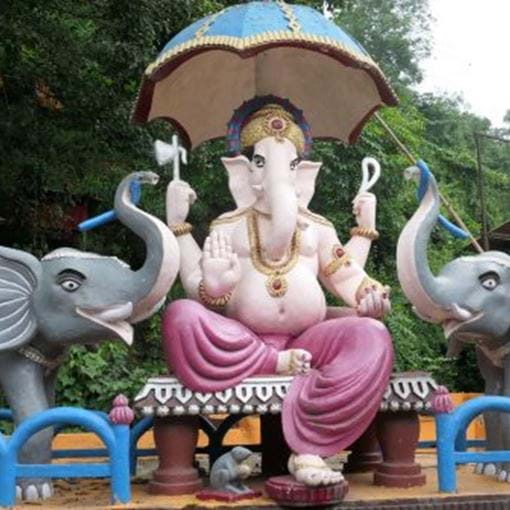
The villages of Basagoan in Tinsukia, the most northerly district of Assam, did not have a problem with elephants until recently when a bridge was built over two subsidiary rivers of the Brahmaputra. This construction has disrupted the annual north-south migration of elephants from the southern border of Assam to Arunachal Pradesh. Instead of wending along their traditional route on the far side of the river, these elephants must now bypass the bridge and thus encounter the Basagoan rice fields and a welcome overnight forage. One or two elephants spending the night in a rice field is one thing. A herd of 200 is quite another. By morning, there is little rice left. A year’s supply of subsistence food consumed in a single sitting.
Our project is helping vulnerable villagers and elephants live peaceably side by side.As the bridge is now a fixture and the elephants’ customary route off-limits, we have two options. One is to help villagers defend their rice from hungry elephants by training farmers to install temporary solar-powered electric fencing around paddy fields until their crop is harvested.
We also suggest they plant bio-barriers of tangy plants such as chillies, limes and ginger around structures that store their harvested paddy because those crops sell well and are not eaten by elephants.
The other option, to off-set losses incurred by elephants, is to help villagers generate cash by selling surplus garden produce along with high-value items such as eggs, chickens, and medicinal herbs. Many women also want to improve their traditional weaving skills while others ask to learn about bee-keeping and farming fish. The choice is theirs. We provide the means.
To safeguard elephants, we must safeguard the people who put up with them. Farm crops are also eaten by pigs, rats, monkeys and birds and those losses can undermine rural livelihoods as much as elephants do. But elephants are huge and alarming at close quarters. Even more so if they too become scared upon entering unfamiliar territory. Human-elephant encounters can then become defensive-aggressive, risking casualties on both sides. Our project aims to help people and elephants coexist. Aggression will not achieve that.
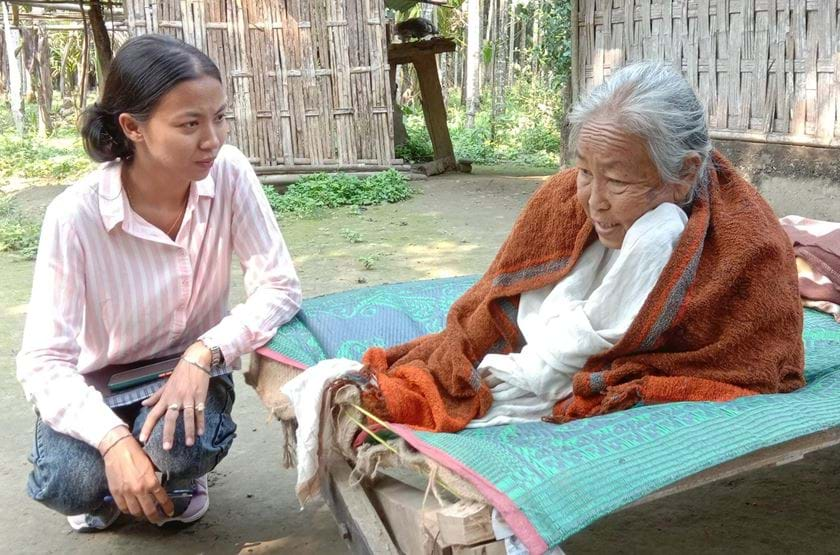
In Basagoan I and my Aaranyak colleagues met an elderly woman sitting, hunched and glum, on an outdoor bed. She seemed older than me but was, in fact, younger. Her name was Menuma Gagoi. She lived with her husband, Bedachandra, in a small wooden house on stilts. Its walls were made of woven bamboo. They lived alone because – unusual in India – they had no children. They depend on neighbours for help.
Two months before my visit, on a moonless night when the village electrics had once again failed, two male elephants walked across their garden. One fed on the grass growing around the plot. The other smelled food inside their house. Section by section, he tore down its flimsy back wall and then used his trunk to grab the bag that held their meagre supply of rice.
All the while, the elderly couple crouched in the far corner of their one-room home, unable to see in the dark, hoping not to be seen. They knew their intruder was an elephant. They knew he could kill them as easily as they could crush a cockroach. They did not know if he would pull down the whole house with them inside it. They were terrified.
It was clear from Menuma’s expressionless face that she was suffering from post-traumatic stress disorder, better known as PTSD. Her husband was desperate to improve his home protection. Neighbours helped as best they could. We gave him a powerful LED torch which he could use as a spotlight to deter future raiders. We hoped it would help them feel safer at night, but it seemed wholly inadequate in the face of such trauma.
Astonishing as it may seem to many of us in Britain, neither Menuma nor Bedachandra wanted their assailant, or any other elephant, killed in retaliation. They just wanted protection, to feel safe in their home and garden.
(Image: Bedachandra Gagoi 75, Menuma’s husband, with Zakir Bora, Aaranyak’s team leader in E. Assam. Behind them, the house the elephant broke into.)
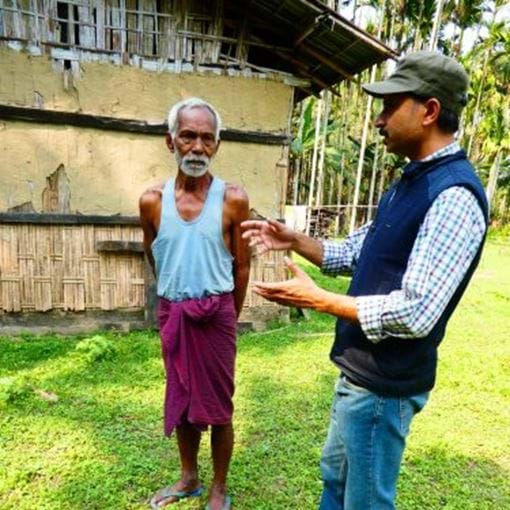
On 1st April, less than a month after I met her, Menuma died. She was only 65. The memory of that terrifying night, the shock, and the stress of knowing it could happen again, had overwhelmed her.
Human-elephant conflict does more than make a mess of the landscape. It threatens the lives and livelihoods of elephants as well as people. Not everyone is as tolerant, or as forgiving, as Menuma and Bedachandra. Elephants are often killed in retaliation for the disruption they cause.
As are moles. When I heard about that case of human-wildlife conflict in a village near me, I was a lot less sympathetic than I might have been had I not met Menuma and watched her kindly face as she told us, in a slow, quiet monotone, about the fateful night that frightened her to death.
In memoriam: Menuma Gagoi.
A lovely, kind-hearted woman.
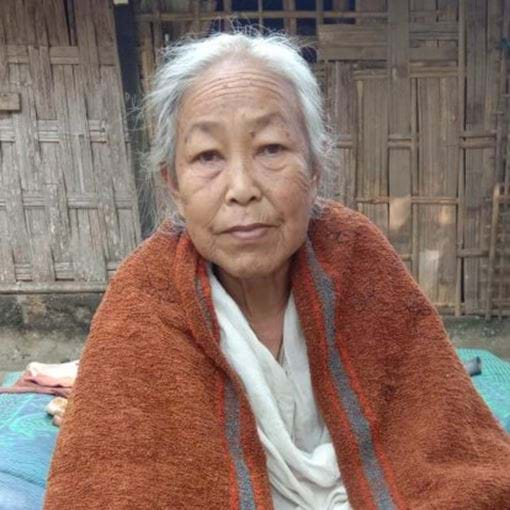
By Belinda Stewart-Cox
British Asian Trust and Elephant Family Conservation Advisor and N.E. India Project Leader
